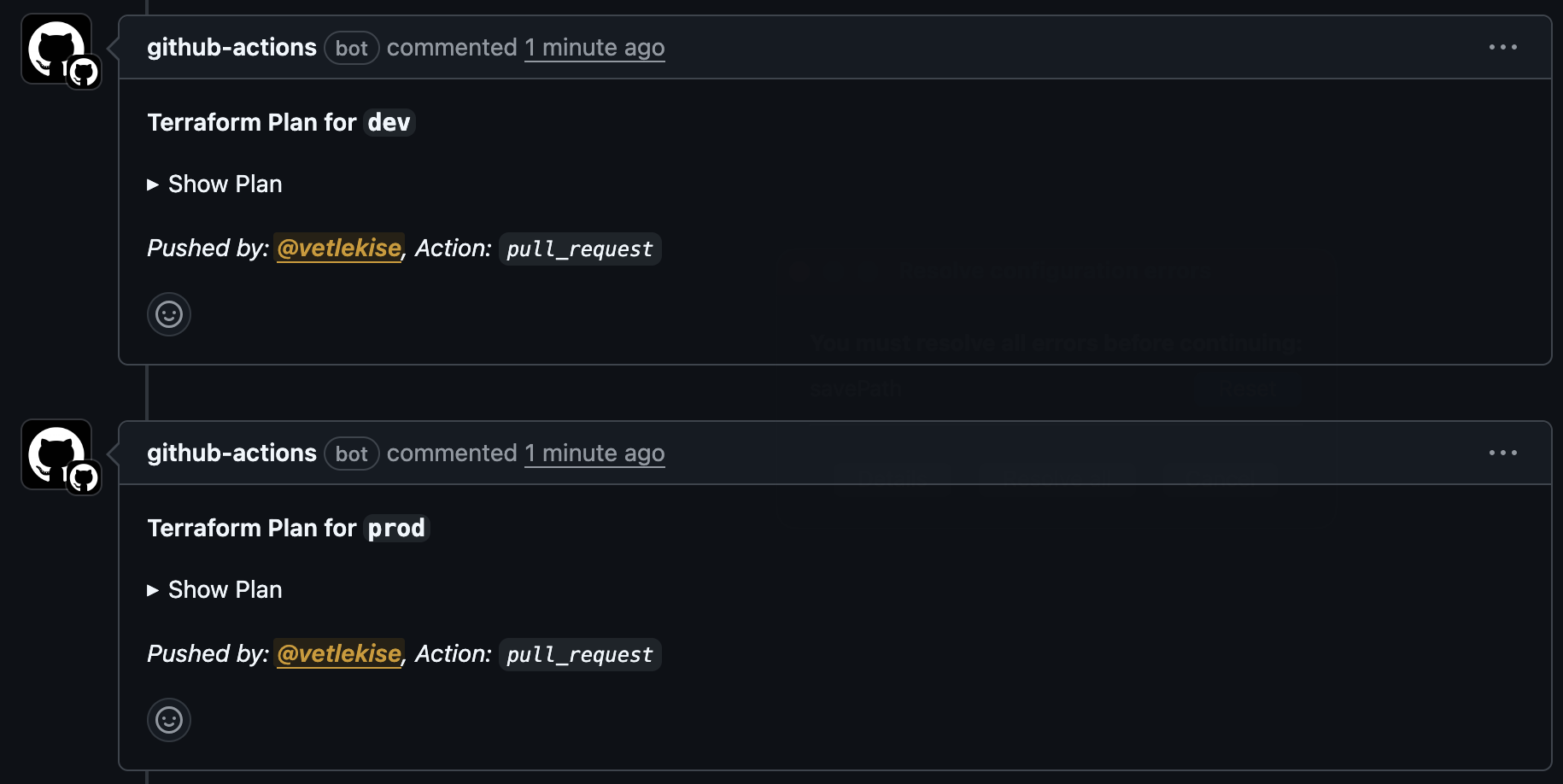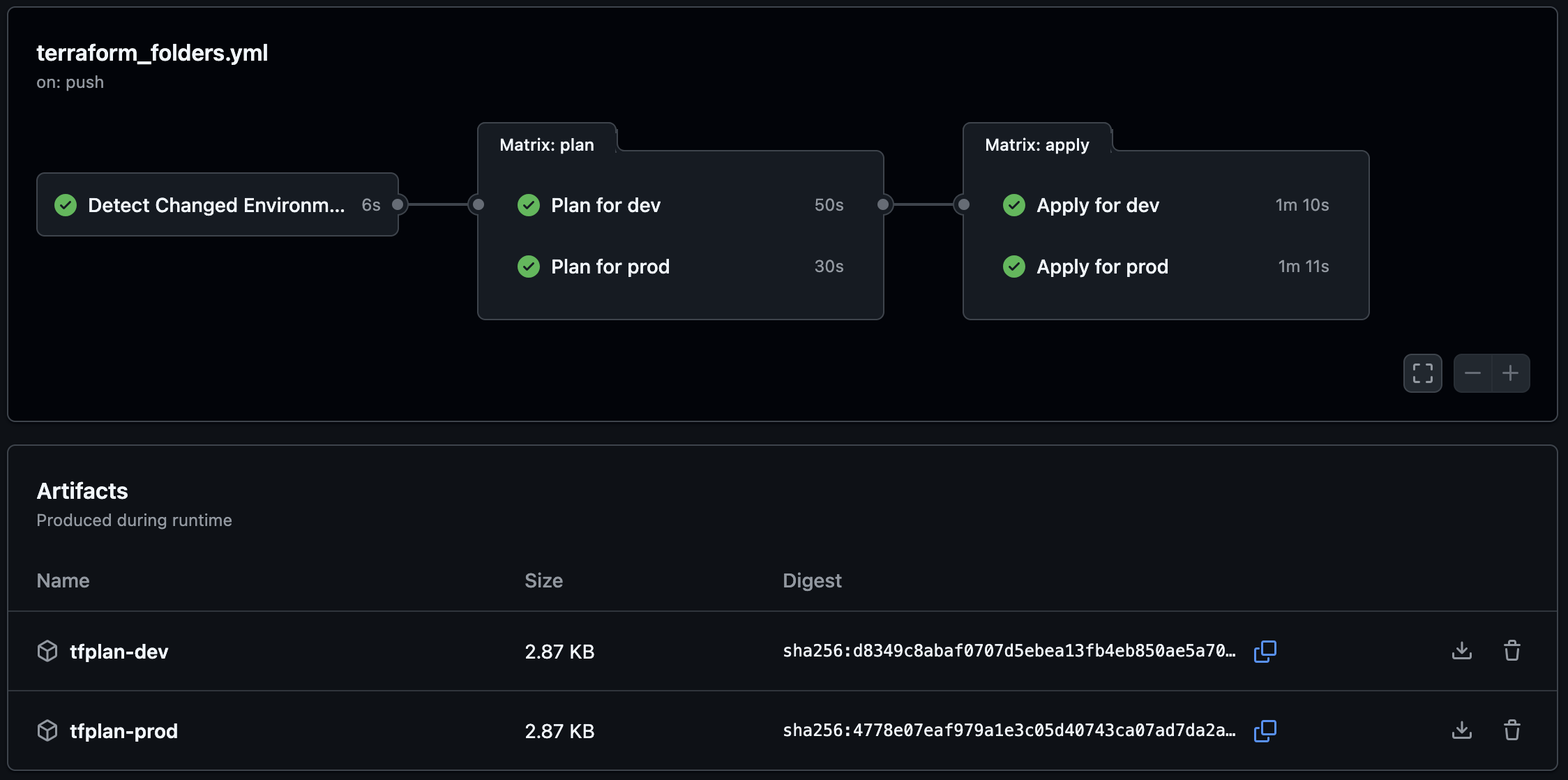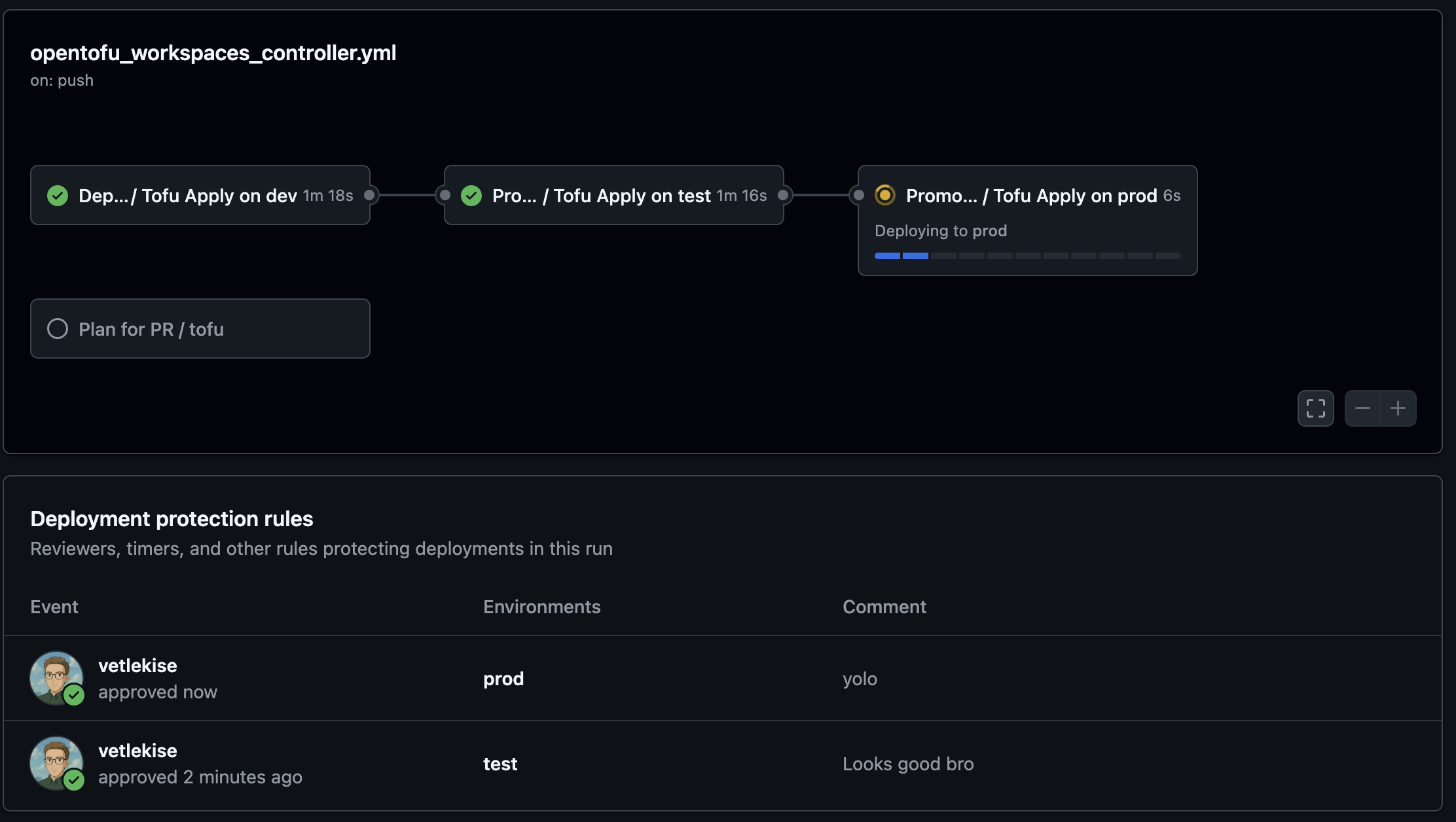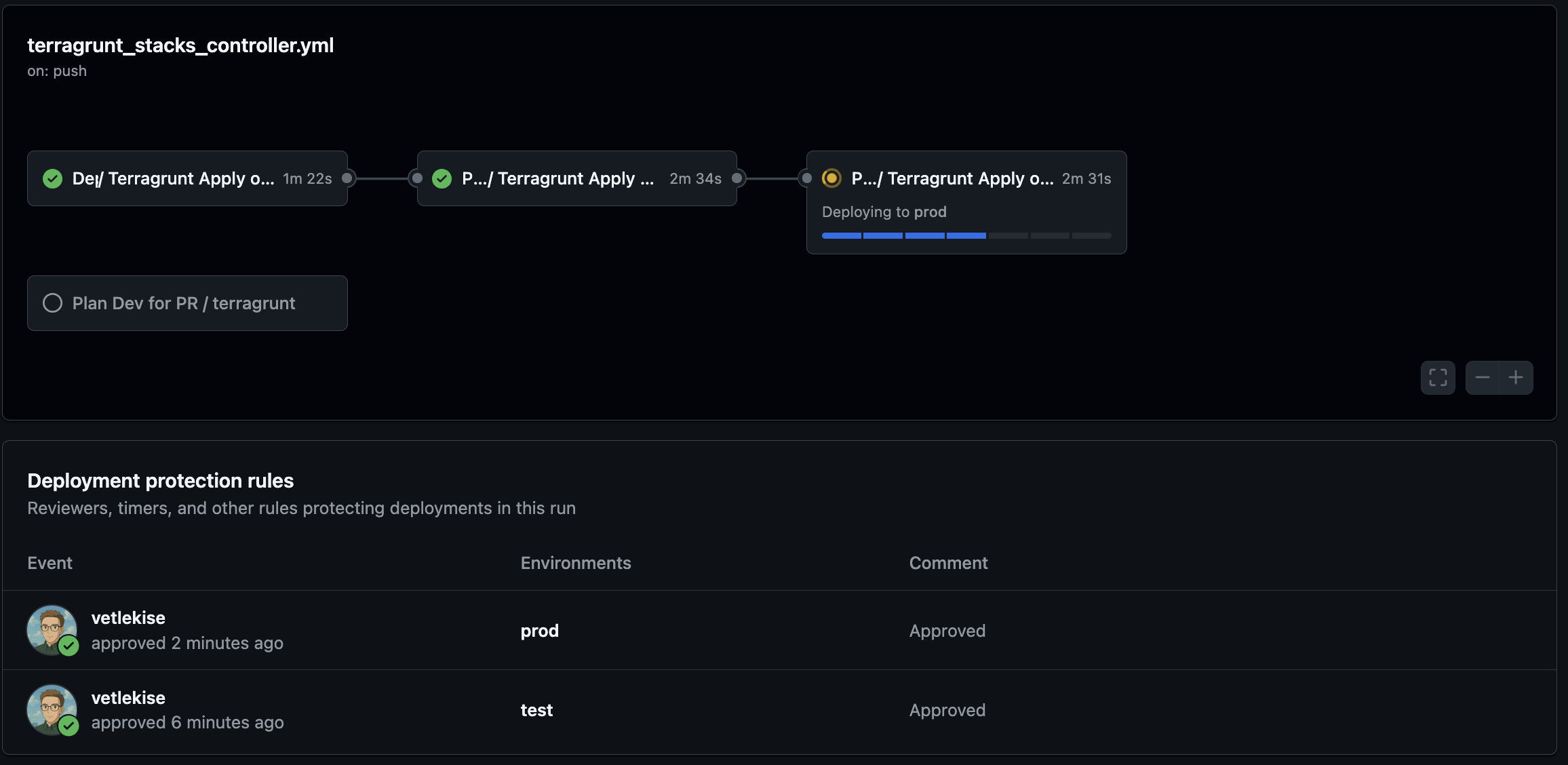Introduction
Every project starts simple, but when managing infrastructure for dev, test, and prod, let alone multiple customers, it quickly becomes complex. How can we solve this chaos?
We’ll tackle the common issues of scalable IaC, and go through a clear journey from basic patterns to something more advanced, showing you how to choose the right tool for the job.
Isolated Folders
This is the classic starting point when trying to figure out multi-environment setups. Its the simplest way to manage multiple environments by giving each one its own dedicated directory.
Pros
- Each environment has its own dedicated directory and state file, providing the highest level of safety and preventing accidental cross-environment changes.
- The structure is straightforward and very easy to understand, making it an excellent starting point for new projects or teams.
- The logic is intuitive, which is ideal for those new to Infrastructure as Code (IaC).
Cons
- You must repeat boilerplate code (like providers and variables) for each environment, which violates the Don’t Repeat Yourself (DRY) principle.
- As the project grows, making a change to a shared component requires updating it in every single folder, which is tedious and error-prone.
- This pattern quickly becomes unmanageable and inefficient when dealing with a large number of environments.
Project Structure
Your repository will typically be organized into dev, test, and prod directories. Each environment then calls the modules from versioned repositories.
Note: Instead of using separate repositories for your modules, you could create a modules directory. Problem with this is versioning and its difficult for others to reuse your module.
1
2
3
4
5
6
7
8
9
10
|
application/
├── dev/
│ ├── main.tf # Calls the versioned 'core-infra'
│ ├── variables.tf # Declares variables for the dev environment
│ └── terraform.tfvars # Assigns values for dev
│
└── prod/
├── main.tf
├── variables.tf
└── terraform.tfvars
|
Configuration Examples
Let’s say you have another repository acting as a Terraform module called core-infra and you want this deployed to the dev environment. This module has its own variables.tf with variable declarations (aka. input parameters). You then declare the required variables in your application repo dev/variables.tf:
1
2
3
4
5
6
7
8
9
10
11
12
13
14
|
variable "vm_count" {
description = "Number of Azure Virtual Machines."
type = number
}
variable "vm_size" {
description = "The Azure VM size."
type = string
}
variable "location" {
description = "The Azure region where resources will be deployed."
type = string
}
|
This is where the duplicate code comes in. You’ve now declared variables in dev/variables.tf, but now you want to deploy the same module to the prod environment, so now you have to duplicate the variables in prod/variables.tf
To provide values to the variables you add the following to dev/terraform.tfvars:
1
2
3
|
vm_count = 1
vm_size = "Standard_B1s"
location = "Norway East"
|
In dev/main.tf is where you would call your reusable module core-infra.
1
2
3
4
5
6
7
8
9
10
|
module "core_infra" {
# Source points to a separate Git repo and a specific version tag
source = "[email protected]:your-org/core-infra.git?ref=v1.0.0"
# Pass values to the module
environment = "dev"
vm_count = var.vm_count
vm_size = var.vm_size
location = var.location
}
|
Why not hardcode all the values in the module call you ask?
A .tfvars file acts as a clean, simple input sheet for an environment. Someone less familiar with Terraform would immediately see all the key parameters instead of needing to look in the configuration files. You can also easily override them using terraform apply -var="location=westeurope" which makes automation easier.
Local Workflow
To deploy the dev environment, navigate into its folder within the application repo and apply the configuration:
1
2
3
4
5
6
7
8
9
10
|
# 1. Clone the live application repo and change into it
git clone [email protected]:your-org/application.git
cd application/dev
# 2. Initialize Terraform (this will download the module from Git)
terraform init
# 3. Plan and Apply
terraform plan
terraform apply
|
CI/CD Pipeline (GitHub Actions)
The following workflow example is dynamic. It looks at the changed environments and builds a matrix to dynamically run plan and apply to the correct environment.
1
2
3
4
5
6
7
8
9
10
11
12
13
14
15
16
17
18
19
20
21
22
23
24
25
26
27
28
29
30
31
32
33
34
35
36
37
38
39
40
41
42
43
44
45
46
47
48
49
50
51
52
53
54
55
56
57
58
59
60
61
62
63
64
65
66
67
68
69
70
71
72
73
74
75
76
77
78
79
80
81
82
83
84
85
86
87
88
89
90
91
92
93
94
95
96
97
98
99
100
101
102
103
104
105
106
107
108
109
110
111
112
113
114
115
116
117
118
119
120
121
122
123
124
125
126
127
128
129
130
131
132
133
134
135
136
137
138
139
140
141
142
143
144
145
146
147
148
149
|
name: 'Terraform Folders'
on:
pull_request:
types: [opened, synchronize, reopened]
branches: [main]
paths:
- 'dev/**'
- 'prod/**'
push:
branches: [main]
paths:
- 'dev/**'
- 'prod/**'
# Add permissions for writing PR comments.
# You may need to add more permissions here for your cloud provider's OIDC.
permissions:
pull-requests: write
# Example for OIDC:
# id-token: write
# contents: read
jobs:
detect-changes:
name: 'Detect Changed Environments'
runs-on: ubuntu-latest
outputs:
environments: ${{ steps.filter.outputs.all_changed_files }}
steps:
- name: 'Checkout Code'
uses: actions/checkout@v5
with:
fetch-depth: 0
- name: 'Find changed environment folders'
id: filter
uses: tj-actions/changed-files@v44
with:
# Since dev/prod are in root, the base path is the repository root
path: '.'
dir_names: "true"
json: true
escape_json: false
# Define the environment folders to watch for changes
files: |
dev/**
prod/**
- name: 'Debug Output'
run: |
echo "Detected changes: ${{ steps.filter.outputs.all_changed_files }}"
plan:
name: 'Plan for ${{ matrix.environment }}'
runs-on: ubuntu-latest
needs: detect-changes
if: needs.detect-changes.outputs.environments != '[]'
strategy:
matrix:
environment: ${{ fromJson(needs.detect-changes.outputs.environments) }}
steps:
- name: 'Checkout Code'
uses: actions/checkout@v5
- name: 'Setup Terraform'
uses: hashicorp/setup-terraform@v3
# Add your cloud provider login step here.
- name: 'Terraform Init'
id: init
working-directory: ${{ matrix.environment }}
run: terraform init -no-color
- name: 'Terraform Plan'
id: plan
working-directory: ${{ matrix.environment }}
run: terraform plan -no-color -out=tfplan
- name: 'Upload Plan Artifact'
uses: actions/upload-artifact@v4
with:
name: tfplan-${{ matrix.environment }}
path: ${{ matrix.environment }}/tfplan
- name: Post Plan Comment to PR
if: steps.plan.outcome == 'success' && github.event_name == 'pull_request'
uses: actions/github-script@v8
env:
PLAN: "${{ steps.plan.outputs.stdout }}"
with:
script: |
const { PLAN } = process.env;
const output = `#### Terraform Plan for \`${{ matrix.environment }}\`
<details><summary>Show Plan</summary>
\`\`\`terraform
${PLAN}
\`\`\`
</details>
*Pushed by: @${{ github.actor }}, Action: \`${{ github.event_name }}\`*`;
await github.rest.issues.createComment({
owner: context.repo.owner,
repo: context.repo.repo,
issue_number: context.issue.number,
body: output
});
apply:
name: 'Apply for ${{ matrix.environment }}'
runs-on: ubuntu-latest
needs: [detect-changes, plan]
if: github.event_name == 'push' && github.ref == 'refs/heads/main' && needs.detect-changes.outputs.environments != '[]'
strategy:
matrix:
environment: ${{ fromJson(needs.detect-changes.outputs.environments) }}
steps:
- name: 'Checkout Code'
uses: actions/checkout@v5
- name: 'Setup Terraform'
uses: hashicorp/setup-terraform@v3
# Add your cloud provider login step here (same as in the plan job).
- name: 'Download Plan Artifact'
uses: actions/download-artifact@v5
with:
name: tfplan-${{ matrix.environment }}
path: ${{ matrix.environment }}
- name: 'Terraform Init'
id: init
working-directory: ${{ matrix.environment }}
run: terraform init -no-color
- name: 'Terraform Apply'
id: apply
working-directory: ${{ matrix.environment }}
run: terraform apply -auto-approve "tfplan"
|


OpenTofu Workspaces
Terraform has a feature called Workspaces that’s used to deploy the same code to multiple environments, keeping your configuration DRY. It still uses one backend but creates separate states for better isolation.
While Terraform workspaces work, we are going to leverage an exclusive OpenTofu feature early variable evaluation to make our lives easier.
FAILS in Terraform:
1
2
3
4
5
6
|
# You cannot enable or disable a module based on the workspace.
module "monitoring_alerts" {
source = "./modules/monitoring"
count = terraform.workspace == "prod" ? 1 : 0 # ERROR
}
|
WORKS in OpenTofu:
1
2
3
4
5
6
|
# You can enable or disable a modules based on the workspace.
module "monitoring_alerts" {
source = "./modules/monitoring"
count = tofu.workspace == "prod" ? 1 : 0
}
|
Pros
- It keeps your codebase clean by using a single set of configuration files for all environments, eliminating boilerplate code.
- Workspaces provide a safe way to manage separate state files for each environment while using the same backend configuration.
- You can efficiently manage a single application or service across multiple similar environments from one place.
Cons
- As environments diverge, the code can become cluttered with complex conditional logic (
count, for_each), making it hard to read and maintain.
- A mistake in the single codebase can potentially affect all environments, as they are not fully isolated at the code level.
- The pattern is less suitable for managing vastly different environments, as forcing all variations into one set of files leads to overly complicated configurations.
Project Structure
With workspaces, your directory structure becomes quite simple. All your config for the application lives in a single folder:
1
2
3
4
5
6
|
application/
├── main.tf # The main logic.
├── variables.tf # A SINGLE declaration of all variables
├── dev.tfvars # Values for the 'dev' environment
├── prod.tfvars # Values for the 'prod' environment
└── backend.tf # Defines the remote state backend
|
Note: Example above only uses a main.tf file, but there’s nothing stopping you from creating more configurations!
Configuration Examples
variables.tf
Variables are declared only once.
1
2
3
4
5
6
7
8
9
10
11
12
13
14
|
variable "vm_count" {
description = "The number of Azure Virtual Machines."
type = number
}
variable "vm_size" {
description = "The Azure VM size (e.g., 'Standard_B1s')."
type = string
}
variable "location" {
description = "The Azure region where resources will be deployed."
type = string
}
|
<insert_env>.tfvars
Provides specific values for each environment.
1
2
3
|
vm_count = 1
vm_size = "Standard_B1s"
location = "Norway East"
|
main.tf
Handle resource creation with conditionals.
1
2
3
4
5
6
7
8
9
10
11
12
13
14
15
16
17
|
# This main module is enabled for all workspaces
module "core_infra" {
source = "[email protected]:your-org/core-infra.git?ref=v1.0.0"
vm_count = var.vm_count
vm_size = var.vm_size
location = var.location
environment = tofu.workspace # The workspace name is used to tag resources
}
# The monitoring module is conditionally enabled only in the 'prod' environment
module "monitoring_alerts" {
source = "[email protected]:your-org/monitoring-alerts.git?ref=v1.2.0"
# This works perfectly in OpenTofu, allowing dynamic environments
count = tofu.workspace == "prod" ? 1 : 0
}
|
Local Workflow
The workflow involves selecting the correct workspace context before applying.
1
2
3
4
5
6
7
8
9
10
11
12
13
14
15
16
17
18
|
# 1. Clone the application repo and change into it
git clone [email protected]:your-org/application.git
cd application
# 2. Initialize OpenTofu (this will download the module from Git)
tofu init
# 3. Create workspaces
tofu workspace new dev
tofu workspace new prod
# 4. Deploy to 'dev'
# 4.1 Switch to the 'dev' workspace
tofu workspace select dev
# 4.2 Plan and apply, specifying the correct .tfvars file
tofu plan -var-file="dev.tfvars"
tofu apply -var-file="dev.tfvars"
|
CI/CD Pipeline (GitHub Actions)
This pipeline uses a GitHub Actions feature called reusable workflows to keep your pipeline DRY and easy to manage. The logic is split into two files: a reusable worker that performs the deployment, and a main orchestrator that defines the release process.
reusable-worker.yml
Contains all the steps to deploy to any single environment. It accepts an environment name as an input, which it uses to dynamically select the correct OpenTofu workspace and tfvars file. This means you only have to define your deployment logic once.
1
2
3
4
5
6
7
8
9
10
11
12
13
14
15
16
17
18
19
20
21
22
23
24
25
26
27
28
29
30
31
32
33
34
35
36
37
38
39
40
41
42
43
44
45
46
47
48
49
50
51
52
53
54
55
56
57
58
59
60
61
62
63
64
65
66
67
68
69
70
71
72
73
74
75
76
77
78
|
name: 'Tofu Reusable Worker'
on:
workflow_call:
inputs:
environment:
required: true
type: string
plan_only:
required: false
type: boolean
default: false
permissions:
id-token: write
contents: read
pull-requests: write
jobs:
tofu:
name: "Tofu ${{ inputs.plan_only && 'Plan' || 'Apply' }} on ${{ inputs.environment }}"
runs-on: ubuntu-latest
environment: ${{ inputs.environment }}
steps:
- name: 'Checkout Code'
uses: actions/checkout@v4
- name: 'Setup OpenTofu'
uses: opentofu/setup-opentofu@v1
# Add your cloud provider login here.
- name: 'Tofu Init'
run: tofu init
- name: 'Select or Create Workspace'
run: tofu workspace select -or-create ${{ inputs.environment }}
- name: 'Tofu Validate'
run: tofu validate -no-color
- name: 'Tofu Plan'
id: plan
run: tofu plan -var-file="${{ inputs.environment }}.tfvars" -no-color -out=tfplan
continue-on-error: ${{ inputs.plan_only }}
- name: 'Post Plan Comment to PR'
if: inputs.plan_only && github.event_name == 'pull_request'
uses: actions/github-script@v7
env:
PLAN: "tofu\n${{ steps.plan.outputs.stdout }}"
with:
script: |
const { PLAN } = process.env;
const output = `#### OpenTofu Plan 📖 \`${{ github.event.pull_request.head.sha }}\` for \`${{ inputs.environment }}\`
<details><summary>Show Plan</summary>
\`\`\`\n${PLAN}\n\`\`\`
</details>
*Pushed by: @${{ github.actor }}, Action: \`${{ github.event_name }}\`*`;
await github.rest.issues.createComment({
owner: context.repo.owner,
repo: context.repo.repo,
issue_number: context.issue.number,
body: output
});
if ("${{ steps.plan.outcome }}" == "failure") {
process.exit(1);
}
- name: 'Tofu Apply'
if: inputs.plan_only == false && steps.plan.outcome == 'success'
run: tofu apply -auto-approve "tfplan"
|
deploy-orchestrator.yml
The main pipeline orchestrates the release by calling the reusable workflow for each stage. The needs: keyword creates a promotion chain, ensuring dev deploys first, followed by test, and finally prod. Each job simply passes the correct environment name to the reusable workflow.
1
2
3
4
5
6
7
8
9
10
11
12
13
14
15
16
17
18
19
20
21
22
23
24
25
26
27
28
29
30
31
32
33
34
35
36
37
38
39
40
41
42
43
44
45
46
|
name: 'Tofu Deploy Orchestrator'
on:
push:
branches:
- main
pull_request:
branches:
- main
permissions:
id-token: write
contents: read
pull-requests: write
jobs:
plan:
name: 'Plan for PR'
if: github.event_name == 'pull_request'
uses: ./.github/workflows/opentofu_workspaces_reusable.yml
with:
environment: dev
plan_only: true
deploy-dev:
name: 'Deploy to DEV'
if: github.event_name == 'push'
uses: ./.github/workflows/opentofu_workspaces_reusable.yml
with:
environment: dev
deploy-test:
name: 'Promote to TEST'
if: github.event_name == 'push'
needs: deploy-dev
uses: ./.github/workflows/opentofu_workspaces_reusable.yml
with:
environment: test
deploy-prod:
name: 'Promote to PROD'
if: github.event_name == 'push'
needs: deploy-test
uses: ./.github/workflows/opentofu_workspaces_reusable.yml
with:
environment: prod
|

Terragrunt Explicit Stacks
As your application grows, its infrastructure often evolves from a single component into a stack of several services. Managing the deployment order and dependencies of a complex stack with plain OpenTofu/Terraform can become difficult.
This is where Terragrunt, a thin wrapper for OpenTofu and Terraform, becomes essential. It excels at managing multi-component applications and keeping your configurations DRY. Specifically, the modern Explicit Stack pattern provides a powerful “blueprint” model to define and generate your entire infrastructure.
Pros
- Define an entire stack once in a
terragrunt.stack.hcl blueprint, then easily create copies for dev, test, and prod.
- See the complete composition of an environment in a single, clear blueprint file.
- Terragrunt builds a deployment graph from your blueprint, automatically ensuring the correct deployment order.
- Plan or apply an entire environment with a single command, like
terragrunt stack run apply.
Cons
- Requires learning the advanced blueprint concepts of
unit blocks, values, and the generation process.
- Auto-generated files in the
.terragrunt-stack directory can make debugging feel less direct than with simpler models.
- The required structure (
units, stacks) can be overkill for smaller projects.
Project Structure
Terragrunt separates your live infrastructure configuration from your reusable modules. Your Terraform modules live in their own versioned Git repositories, while your live infrastructure repository contains the units (wrappers) and stacks (blueprints).
1
2
3
4
5
6
7
8
9
10
11
12
13
14
|
application/
├── root.hcl # Root config (backend, common variables)
│
├── units/
│ ├── resource_group/
│ │ └── terragrunt.hcl # Reusable wrapper for a resource_group module
│ └── storage_account/
│ └── terragrunt.hcl # Reusable wrapper for a storage_account module
│
└── stacks/
└── dev/
│ └── terragrunt.stack.hcl # THE BLUEPRINT for the 'dev' environment
└── prod/
└── terragrunt.stack.hcl # THE BLUEPRINT for the 'prod' environment
|
Configuration Examples
root.hcl
This file, at the top of your repository, defines configurations that are inherited by all other modules, eliminating repetition.
1
2
3
4
5
6
7
8
9
10
11
12
13
14
15
16
17
18
19
20
21
22
23
24
25
26
27
28
29
30
31
32
|
# Configure the remote state backend ONCE for all modules.
remote_state {
backend = "azurerm"
generate = {
path = "backend.tf"
if_exists = "overwrite_terragrunt"
}
config = {
use_azuread_auth = true
use_oidc = true
resource_group_name = ""
storage_account_name = ""
container_name = ""
key = "${path_relative_to_include()}/terraform.tfstate" # e.g. dev/vnet/terraform.tfstate
}
}
# Generate an Azure provider block for every module
generate "provider" {
path = "provider.tf"
if_exists = "overwrite_terragrunt"
contents = <<EOF
provider "azurerm" {
features {}
}
EOF
}
# Define common inputs for all modules in this repo
inputs = {
location = "norwayeast"
}
|
units/resource_group/terragrunt.hcl
This is a reusable “unit template” that wraps your Terraform module. The values object is used to access variables passed down from the blueprint.
1
2
3
4
5
6
7
8
9
10
11
12
13
14
|
include "root" {
path = find_in_parent_folders("root.hcl")
}
terraform {
# The source URL is in from the blueprint
source = values.module_source
}
# The inputs are also passed in from the blueprint's 'values'
inputs = {
name = values.name
environment = values.environment
}
|
units/storage_account/terragrunt.hcl
This unit template shows how to define a dependency. The config_path uses a variable that will be provided by the blueprint.
1
2
3
4
5
6
7
8
9
10
11
12
13
14
15
16
17
18
19
20
21
22
23
24
|
include "root" {
path = find_in_parent_folders("root.hcl")
}
terraform {
# The source URL is passed in from the blueprint
source = values.module_source
}
dependency "resource_group" {
# The path to the dependency is passed in from the blueprint
config_path = values.resource_group_path
mock_outputs = {
# The mock value is passed in from the blueprint
rg_name = values.mock_rg_name
}
}
inputs = {
name = values.name
environment = values.environment
rg_name = dependency.resource_group.outputs.rg_name
}
|
stacks/dev/terragrunt.stack.hcl
This is the blueprint. It assembles the final environment by pointing to the reusable units and providing the specific values for dev.
1
2
3
4
5
6
7
8
9
10
11
12
13
14
15
16
17
18
19
20
21
22
23
24
25
26
27
28
29
30
31
32
33
34
35
36
|
unit "resource_group" {
# Source points to our reusable Unit Template
source = "../../units/resource_group"
path = "resource_group"
# These 'values' are passed as variables to the unit's terragrunt.hcl
values = {
# This points to your versioned Terraform module repository
module_source = "git::[email protected]:your-org/terraform-azurerm-resource-group.git?ref=v1.0.0"
# Module-specific inputs
name = "grunt-dev"
environment = "dev"
}
}
unit "storage_account" {
source = "../../units/storage_account"
path = "storage_account"
values = {
# This points to your versioned Terraform module repository
module_source = "git::[email protected]:your-org/terraform-azurerm-storage-account.git?ref=v1.2.0"
# Module-specific inputs
name = "gruntdev932847"
environment = "dev"
# We pass the relative path that the dependency
# block in the unit template needs to find the other generated unit.
resource_group_path = "../resource_group"
# We also pass the mock value to keep the unit template generic.
mock_rg_name = "grunt-dev"
}
}
|
Local Workflow
To deploy the entire dev stack, you run a stack command from the directory containing the blueprint.
1
2
3
4
5
6
7
8
|
# Clone repository
git clone [email protected]:your-org/application.git
# Navigate to the blueprint's folder
cd stacks/dev
# This single command generates, plans, and applies the entire stack in the correct order.
terragrunt stack run plan
terragrunt stack run apply
|
CI/CD Pipeline (GitHub Actions)
Similar to how we did the OpenTofu pipeline, this uses a reusable workflow to create a promotion path from dev to prod. The entire process is driven by the stack blueprints.
reusable-worker.yml
This workflow performs the plan or apply for a single environment. It’s cloud-agnostic and runs from the repository root.
1
2
3
4
5
6
7
8
9
10
11
12
13
14
15
16
17
18
19
20
21
22
23
24
25
26
27
28
29
30
31
32
33
34
35
36
37
38
39
40
41
42
|
name: 'Terragrunt Reusable Worker'
on:
workflow_call:
inputs:
environment:
required: true
type: string # e.g., "dev", "prod"
plan_only:
required: false
type: boolean
default: false
permissions:
id-token: write # For cloud OIDC login
contents: read
jobs:
terragrunt:
name: "Terragrunt ${{ inputs.plan_only && 'Plan' || 'Apply' }} on ${{ inputs.environment }}"
runs-on: ubuntu-latest
environment: ${{ inputs.environment }}
steps:
- name: 'Checkout Code'
uses: actions/checkout@v4
- name: 'Setup OpenTofu & Terragrunt'
uses: gruntwork-io/terragrunt-action@v3
with:
tg_version: 'v0.90.0'
tofu_version: '1.10.6'
# Add your cloud provider login
- name: 'Terragrunt Plan'
if: inputs.plan_only
working-directory: stacks/${{ inputs.environment }}
run: terragrunt stack run plan
- name: 'Terragrunt Apply'
if: inputs.plan_only == false
working-directory: stacks/${{ inputs.environment }}
run: terragrunt stack run apply --non-interactive
|
deploy-orchestrator.yml
This main pipeline orchestrates the release process by calling the reusable worker for each environment.
1
2
3
4
5
6
7
8
9
10
11
12
13
14
15
16
17
18
19
20
21
22
23
24
25
26
27
28
29
30
31
32
33
34
35
36
|
name: 'Terragrunt Deploy Orchestrator'
on:
push:
branches: [main]
pull_request:
branches: [main]
paths:
- '**.hcl'
- '.github/workflows/**'
jobs:
plan-dev:
name: 'Plan Dev for PR'
if: github.event_name == 'pull_request'
uses: ./.github/workflows/reusable-worker.yml
with:
environment: dev
plan_only: true
secrets: inherit
deploy-dev:
name: 'Deploy to DEV'
if: github.ref == 'refs/heads/main' && github.event_name == 'push'
uses: ./.github/workflows/reusable-worker.yml
with:
environment: dev
secrets: inherit
deploy-prod:
name: 'Promote to PROD'
if: github.ref == 'refs/heads/main' && github.event_name == 'push'
needs: deploy-dev
uses: ./.github/workflows/reusable-worker.yml
with:
environment: prod
secrets: inherit
|

Conclusion
There is no single best solution, only the right one for your project’s current scale and complexity.
| Feature |
Isolated Folders |
OpenTofu Workspaces |
Terragrunt Explicit Stacks |
| Simple to Start |
✅ |
✅ |
🟡 |
| DRY (No Repetition) |
❌ |
✅ |
✅ |
| Strong Code Isolation |
✅ |
🟡 |
✅ |
| Dependency Management |
❌ |
❌ |
✅ |
| Advanced Blueprints |
❌ |
❌ |
✅ |
| Scales for Complex Stacks |
❌ |
🟡 |
✅ |
Note: The GitHub Actions workflows in this article are robust foundations. I encourage you to adapt the triggers, promotion rules, and cloud provider steps to fit your team’s specific needs and policies.
Resources & Links
For more detailed information on stuff used in this article, please refer to the official documentation.



